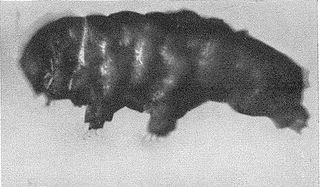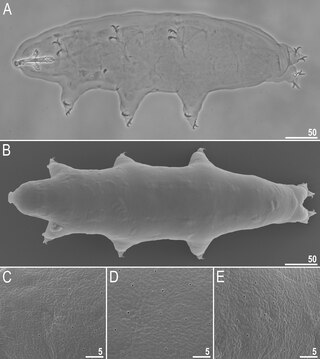
Lobopodians are members of the informal group Lobopodia, or the formally erected phylum Lobopoda Cavalier-Smith (1998). They are panarthropods with stubby legs called lobopods, a term which may also be used as a common name of this group as well. While the definition of lobopodians may differ between literatures, it usually refers to a group of soft-bodied, marine worm-like fossil panarthropods such as Aysheaia and Hallucigenia.

Onychophora, commonly known as velvet worms or more ambiguously as peripatus, is a phylum of elongate, soft-bodied, many-legged panarthropods. In appearance they have variously been compared to worms with legs, caterpillars, and slugs. They prey upon other invertebrates, which they catch by ejecting an adhesive slime. Approximately 200 species of velvet worms have been described, although the true number of species is likely greater. The two extant families of velvet worms are Peripatidae and Peripatopsidae. They show a peculiar distribution, with the peripatids being predominantly equatorial and tropical, while the peripatopsids are all found south of the equator. It is the only phylum within Animalia that is wholly endemic to terrestrial environments, at least among extant members. Velvet worms are generally considered close relatives of the Arthropoda and Tardigrada, with which they form the proposed taxon Panarthropoda. This makes them of palaeontological interest, as they can help reconstruct the ancestral arthropod. In modern zoology they are particularly renowned for their curious mating behaviours and the bearing of live young in some species.

A claw is a curved, pointed appendage found at the end of a toe or finger in most amniotes. Some invertebrates such as beetles and spiders have somewhat similar fine, hooked structures at the end of the leg or tarsus for gripping a surface as they walk. The pincers of crabs, lobsters and scorpions, more formally known as their chelae, are sometimes called claws.

The Malayan porcupine or Himalayan porcupine is a species of rodent in the family Hystricidae. Three subspecies are extant in South and Southeast Asia.

Opiliones are an order of arachnids and share many common characteristics with other arachnids. However, several differences separate harvestmen from other arachnid orders such as spiders. The bodies of opiliones are divided into two tagmata : the abdomen (opisthosoma) and the cephalothorax (prosoma). Unlike spiders, the juncture between the abdomen and cephalothorax is often poorly defined. Harvestmen have chelicerae, pedipalps and four pairs of legs. Most harvestmen have two eyes, although there are eyeless species.

Tardigrades, known colloquially as water bears or moss piglets, are a phylum of eight-legged segmented micro-animals. They were first described by the German zoologist Johann August Ephraim Goeze in 1773, who called them Kleiner Wasserbär. In 1777, the Italian biologist Lazzaro Spallanzani named them Tardigrada, which means "slow steppers".

Macrobrachium ohione, commonly known as the Ohio shrimp, Ohio river shrimp or Ohio river prawn, is a species of freshwater shrimp found in rivers throughout the Gulf of Mexico and Atlantic Ocean drainage basins of North America. It is the best-known of all North American freshwater shrimp, and is commonly used as bait for commercial fishing, especially catfish.
This glossary describes the terms used in formal descriptions of spiders; where applicable these terms are used in describing other arachnids.

Acutuncus is a genus of tardigrades containing a single species, Acutuncus antarcticus. Tardigrades, which are eight-legged micro-animals, are commonly referred to as water bears or moss piglets and are found all over the world in varying extreme habitats. First discovered in 1904 and originally named Hypsibius antarcticus, Acutuncus antarcticus is the most abundant tardigrade species in Antarctica.

Milnesium tardigradum is a cosmopolitan species of tardigrade that can be found in a diverse range of environments. It has also been found in the sea around Antarctica. M. tardigradum was described by Louis Michel François Doyère in 1840. It contains unidentified osmolytes that could potentially provide important information in the process of cryptobiosis.

Milnesium is a genus of tardigrades. It is rather common, being found in a wide variety of habitats across the world. It has a fossil record extending back to the Cretaceous, the oldest species found so far is known from Turonian stage deposits on the east coast of the United States.Milnesiums are one of the most desiccation and radiation-resistant invertebrates on Earth because of their unique ability to transform into a "tun" state and utilize intrinsically disordered proteins when experiencing extreme environments.

Zigrasimecia is an extinct genus of ants which existed in the Cretaceous period approximately 98 million years ago. The first specimens were collected from Burmese amber in Kachin State, 100 kilometres (62 mi) west of Myitkyina town in Myanmar. In 2013, palaeoentomologists Phillip Barden and David Grimaldi published a paper describing and naming Zigrasimecia tonsora. They described a dealate female with unusual features, notably the highly specialized mandibles. Other features include large ocelli, short scapes, 12 antennomeres, small eyes, and a clypeal margin that has a row of peg-like denticles. The genus Zigrasimecia was originally incertae sedis within Formicidae until a second species, Zigrasimecia ferox, was described in 2014, leading to its placement in the subfamily Sphecomyrminae. Later, it was considered to belong to the distinct subfamily Zigrasimeciinae.

Beorn leggi is an extinct species of tardigrades, and the known first fossil tardigrade, discovered c. 1940 and described in 1964 from Late Cretaceous amber from Manitoba, Canada. It is the only species in the genus Beorn, and family Beornidae. It is one of two fossil tardigrades known from the Cretaceous, the other being Milnesium swolenskyi from the Turonian New Jersey amber

Gerontoformica is an extinct genus of stem-group ants. The genus contains thirteen described species known from Late Cretaceous fossils found in Asia and Europe. The species were described between 2004 and 2016, with a number of the species formerly being placed into the junior synonym genus Sphecomyrmodes.
Faxonius maletae, sometimes called the Kisatchie painted crayfish or Kisatchie painted crawfish, is a species of crawdad in the Cambaridae family. The specific epithet maletae is in honor of the discoverer's wife, author Maleta M. Walls, who helped collect many of the original specimens. It was originally described as a subspecies of Orconectes difficilis, but later elevated to full species status. The common name refers to the Kisatchie National Forest, near where the original specimens were found in Bayou Santabarb.

Macrobiotus shonaicus is a species of tardigrade in the family Macrobiotidae. As of 2018 it is only known from its type locality: Tsuruoka, Japan. The species description was published in 2018. The insides of their first three pairs of legs have a slight fold above their claws, and their eggs have processes whose terminal discs split off into thin filaments.

Onychodictyon is a genus of extinct lobopodian known from the Lower Cambrian Chengjiang Maotianshan Shales in the Yunnan Province in China. It was characterized by a stout body covered by fleshy papillae and pairs of sclerotized plates with spines, representing part of the diverse "armoured lobopodians" alongside similar forms such as Microdictyon and Hallucigenia.
Bertolanius is a genus of tardigrades belonging to the family Eohypsibiidae.

Milnesium alpigenum is a species of tardigrade that falls under the Tardigrada phylum. Like its taxonomic relatives it is an omnivorous predator that feeds on other small organisms, such as algae, rotifers, and nematodes. M. alpigenum was discovered by Christian Gottfried Ehrenberg in 1853. It is very closely related to Milnesium tardigradum along with many other species from the Milnesium genus.














